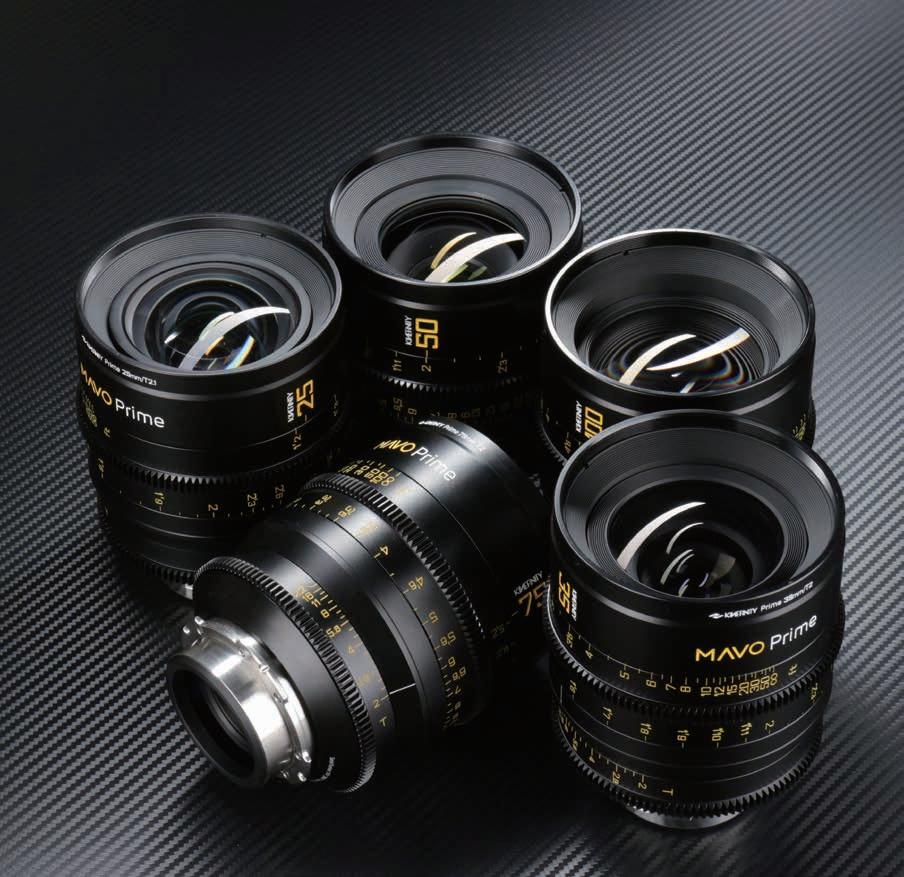
24 minute read
On Set

C. Kim Miles
Sights
csc, mysc UFOs
in PROJECT BLUE BOOK

he historical drama series Project Blue Book, created
Tby David O’Leary, executive produced by Robert Zemeckis and co-produced by the History Channel and A&E Studios, is based on the real-life series of studies of unidentified flying objects that the United States Air Force conducted from the late ‘40s to the late ‘60s. Aidan Gillen plays Dr. J. Allen Hynek, a skeptical astrophysics professor and the chief scientific advisor to the project, while Michael Malarkey plays Captain Michael Quinn, the decorated Second World War veteran who is selected to run the project and partner with Hynek to investigate sightings and unexplained phenomena.

We wanted above all to just be honest to the look of the ‘50s, but with a modern touch, and to be as honest as possible with the lighting and embrace environments and use them to motivate what we were doing lighting-wise so that when we were doing visual effects stuff, the honesty of the photography helped make the visual effects feel more real and not too stylized.
By Fanen Chiahemen • Photographs Ed Araquel
Photography of the 10-episode series, which premiered in January 2019, was handled mostly by C. Kim Miles csc, mysc, who shot the first six episodes, with cinematographer Ken Krawczyk taking over Episodes Seven and Eight while Miles prepped the final two. At the 34 th annual American Society of Cinematographers Awards, held in late January of this year, Miles took home the award in the Episode of a Series for Commercial Television category for his work on the second episode, “The Flatwoods Monster.” Miles says the consistent look of the period show was born out of a directive from O’Leary and co-executive producer Sean Jablonski. “The initial pitch was to imagine The X-Files meets Mad Men, and that was the sort of tagline we stuck to,” Miles says. “We wanted above all to just be honest to the look of the ‘50s, but with a modern touch, and to be as honest as possible with the lighting and embrace environments and use them to motivate what we were doing lightingwise so that when we were doing visual effects stuff, the honesty of the photography helped make the visual effects feel more real and not too stylized.” Production designer Ross Dempster was instrumental in achieving that vision, Miles says. “He brought a very grounded sensibility to the design of the show in terms of sets and costumes. We were already telling a story that involves UFOs, and there’s a certain suspension of disbelief with that, so we wanted to keep the rest of it grounded, and in Ross’s textures and colours there are a lot of earth tones, a lot of stuff drawn from midcentury architecture, mid-century furnishings that grounded our characters and locations. “So there are a lot of colour choices in terms of the contemporary worlds that the characters inhabit, which were these pastels and earth tones, and then our artificial lighting – and by that I mean mostly what we did at night – was a blend of introducing sodium lighting for streetlights and mercury vapour lighting, and fluorescent lights, which were brand new back in the ‘50s,” Miles explains. “Our choices were mainly to bring a sense of depth at night. The moonlight colour that gaffer Burton Kuchera and I developed was a cyan and blue over tungsten, so it had a cool but slightly green look to it that contrasts nicely against the warm tones of the sodium streetlights or a mercury vapour streetlight. And the greens and blues tend to allow you to hide a lot of things in the darkness, which we were interested in because one of the things we wanted to avoid was being too on the nose with the visual effects and spoon feeding the audience too much information. Something that always compels me is framing and lighting shots in a way that forces the audience to draw some of their own conclusions and to participate in the telling of the story.” Miles opted to shoot Project Blue Book with the ARRI ALEXA XT, “which is a platform that I trust and use almost exclusively because I know what I’m going to get with it; I know how far I can push it and what I can do to it in post to push it one way or the other towards the look of the show,” he says. “For lenses we looked at Cookes, Master Primes, all sorts of stuff, and we ended up selecting Leica Summilux Primes because of the particularly interesting way they flare when there’s a specular light in the frame,” the DP states. “They have a unique almost futuristic lenticular flare
Below: L-R: 1st AC Aaron Haesler, C. Kim Miles csc, mysc and A Camera Operator Daryl Hartwell. Right: A cam on Libra head and SuperTechno 50 with B cam on Arrihead and dolly in Season One, Episode 1 “The Fuller Dogfight.”


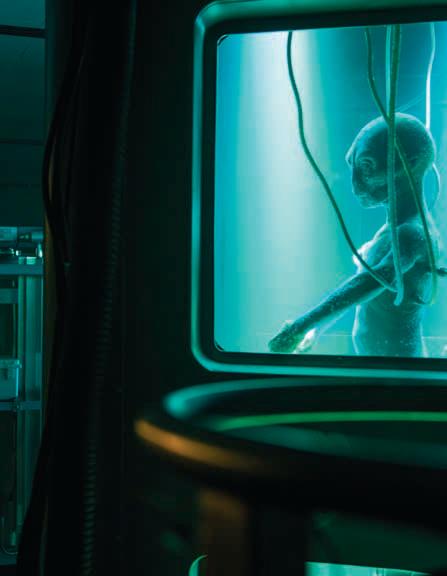

(L-R) Aiden Gillen and Michael Malarkey in “The Washington Merry-Go-Round.”

characteristic throughout the range of lenses that was really interesting to me, and you can see that from time to time in the show. They’re also particularly good with skin tones and portraiture photography on the longer lenses.” A big lighting setup in “The Flatwoods Monster” episode involved a nighttime forest fire sequence, which was shot in Langley, B.C., at a place called Emerald Springs, “an up-and-coming golf course that has a bunch of forested areas that we could shoot in,” Miles says. “In the shot where we see the family at the top of the hill and then we turn around and look over their shoulders at the blazing forest down below them, that was all shot practically. Visual effects helped to build the fire, but Burton lit that place with two Starlights and two 120-foot Condors just spread out all around us. We had elements of interactive fire light that we pushed up in the trees in the surrounding area to create the look of the fire, and in doing so we got to pick our gel colours that we wanted to represent the colour of the fire so that that information could be used by visual effects to motivate colourizing the fire on their end. We just put a bunch of Mini Brutes and Maxi Brutes that were arranged in various positions down at the valley pointing up at the trees, and we had everything on dimmer boards and on iPads to create the flickering fire effect for visual effects to key off of.” Later when Hynek and Quinn arrive in the town to investigate the cause of the mysterious fireball in the woods, they find the family who witnessed it cowering in the dark basement of their house. “I personally was driven by wanting to keep it really honest to what light sources there would be at the time, and I also wanted to keep it dark and mysterious and keep the audience nervous about what they were about to experience,” Miles says of his approach to the scene, which was shot in an old farmhouse. “So the first thing we did was push a little bit of artificial light through the windows down into the basement. I think we had a couple of M40s outside each of the windows, just adding a little splash of daylight into the room in places that we wanted to look. And then we had the lantern that Hynek carries downstairs delivered to the rigging electrics from the props department, and we augmented the light that the lantern was making by fixing LED strips to the off-camera side of the lens to light faces behind it. That way we were able to enter an environment that was lit entirely from the outside that was pretty dark and spooky, and then have a little space around our actors who were holding the lantern so that you could just see what was happening in their faces, but the light would fall off three feet away from them and fall to darkness.” A scene in a crowded speakeasy was also shot in a basement but with a different approach. “We shot that at an old mental hospital called Riverview,” Miles explains. “It was actually shot in this little basement area that is typically used for dungeons and catacombs, but Ross had the vision to dress this underground space and make it into something much different from anything that had ever been done there before and embrace lots of colour. There are lots of ambers and purples and very rich textures and colours. Lighting-wise we embraced that and warmed up a lot of
our stuff and made sure that faces were lit in a really flattering way. In an environment like that, I’ll try to drive everything that I can with practicals and then only augment the practicals around actors’ faces when we need to treat them in a little bit more flattering light than practicals sometimes afford.” Composition and framing were critical to creating suspense, Miles says. “We used lens height to help guide the audience’s experience of each scene and the characters within it. Daryl Hartwell was our A camera operator on the show who’s been doing A camera for me for a number of years now. He’s got a great storytelling sensibility about him; he’s always on top of what it is that we’re trying to tell. Using low angles is something that allows us to show off practical locations that we’re shooting in; you’d never be able to get down low and really wide in a studio environment without getting into a huge visual effects situation. So in some ways, being low and wide gives us a sense of space and a sense of worldliness and allows the show to breathe a little bit.” Predominantly fixing the camera onto a stabilized Libra head on the dolly allowed them to efficiently create complicated camera moves. “We were able to do 15-point or 20-point camera moves inside practical locations or inside sets without having to build great big sections of dance floor or lay down great big sections of track because the stabilized head absorbs a lot of the imperfections in the floor that the dolly’s rolling over,” Miles states. “So it essentially gives a lot of advantage in terms of speed; we’re able to set shots up and do more elaborate setups than we could otherwise do with more conventional means. It’s definitely a more expensive way to do it, but it gives us a real nice advantage in terms of shot design.” How much the second camera is used on the two-camera show “comes down to the director and their sensibiltiies,” Miles maintains. “If we have a more theatrical-minded director, then we tend to be more of a single-camera show, and the B camera runs off and does inserts or establishing shots and that sort of thing. If it’s a more TV-centric director, then we tend to use the B camera a lot more because they’re more driven by watching lots and lots of coverage.” On set DIT Ryan McGregor was also a critical part of the team, Miles says. “Ryan is a great DIT,” the DP offers. “I rely on Ryan quite a great deal to help us with the look of the show. There are times when you can use image technology to help you speed up on set; sometimes you don’t need to light quite as heavily if you can open up shadows artificially in the CDLs or in the LUT, so having a DIT that’s familiar with that sort of strategizing is really helpful.” Miles recalls that it was in fact McGregor who first texted him congratulations on his ASC Award nomination. “It’s still sinking in,” the DP says of his eventual win. “Even being nominated was so outside the box for me. I mean, the ASC is seemingly an unattainable place for me. At least that’s how I looked at it. I never imagined that anyone there would even look at my work, let alone consider it. So that was a huge surprise and a huge honour. More than anything, it’s being recognized by people that I’ve respected and looked up to my entire life.”
Ksenia Solo in Season One, Episode 4, “Operation Paperclip.”
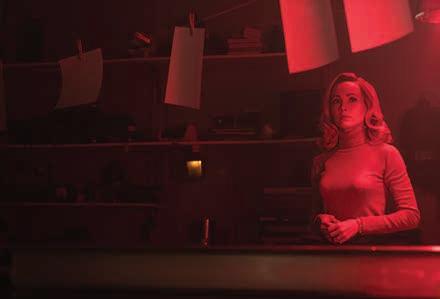
Aidan Gillen in Season One, Episode 2, “The Fuller Dogfight.”

(L-R) Michael Malarkey, Aidan Gillen, Francesca Bianchi and Jesse Irving in Season One, Episode 3, “Lubbock Lights.”


Book cover design by Jake Walton
True North Lloyd Walton on Chasing the Muse
Retired associate life member Lloyd Walton has worn many hats throughout his storied life, from hockey player to pilot to animator to award-winning director and cinematographer. At the height of his career, his major employers included the Ontario government and the Privy Council of Canada. He also ran a small AV and

film department in the Ontario provincial government from the early 1970s to the late 1990s. Since retiring as a cinematographer, he has continued in the creative field as a painter and writer. His latest book, Chasing the Muse: Canada, interweaves many of his life stories as he describes his odyssey in search of Canadian history, identity and landscape. Walton
Old black-and-white CJIC television camera.
tells of his brush with the NHL, rock and roll, near death encounters while on the job, new insights into Canadian history and solving a mystery with his Aaton 16 mm camera in hand. He shared an excerpt from the book with Canadian Cinematographer. trundled upstairs to a darkened room to see a film. A rattling Bell and Howell movie projector at the back of the room illuminated Canadian stories, landscapes, and peoples to an attentive audience. The logo letters “NFB” alerted my sense of patriotism, and the films stirred my sense of wanderlust. I wanted to discover this place called Canada. The National Film Board movies felt real. The first time I was seriously asked what I wanted to be when I grew up was on a local television show, called Kiddies on Camcal hero. It was Bert Luciani, the cameraman. Bert was kind and friendly to this nine-year-old. He held me up to the massive television camera and let me look through the eyepiece. I saw things in a whole new light, in black and white. I could see into people’s faces. When the host finally lay the big question on me, “What would you like to be when you grow up, Lloyd?” I looked straight into the lens and said, “I am going to be a cameraman.” Everyone needs a teacher who influences their life in a meaningful
Excerpt from Chasing the Muse: Canada by Lloyd Walton
Photos excerpted from Chasing the Muse: Canada courtesy of Lloyd Walton.
Imust have been eight years old when our grade three class first era. On my day for the show, I was impressed with another loway, and I have had many, including my animation teacher, Hans Kohlund at the Ontario College of Art. To hammer home a point, Hans would fall to the floor, roll over in a somersault, kick his legs in the air, then spring back to his feet, continuing the lecture with his cigarette perched on his lips, dangling a gravity-defying two-inch ash. A magician always uses diversion. Our eyes were focused on the diversion while our minds absorbed his message. The week after I graduated from OCA, I sold my animated film, Peace and Quiet to the CBC. I also met a fast-talking film distributor, a young Ivan Reitman who, in his Yorkville office, with feet on his desk, offered to take Peace and Quiet for theatrical distribution. I delivered a print to him. I never heard from him again. A review in the University of Toronto’s Varsity magazine called Peace and Quiet “simple, controlled, and very funny.” I was on my way. I was an animator. Animation, I sadly found out, was out of vogue in the advertising industry. The secret to a successful career is to find something you love to do and get someone to pay you to do it. Ontario Provincial Parks were expanding in size, and the number of visitors was increasing dramatically. I was hired on a two-month contract to produce automated slide shows for the
Top: Biba Tharp in Natural Journey. Bottom: A voyageur brigade.
outdoor amphitheatres in the parks. I was in for a ride and I knew it; that is, if I could stay longer than two months. Mixing my photography with good scripts, working in recording studios with actors and announcers, choosing the music and directing the mix, I was experimenting with a new medium. A lot of it was timing. I learned that I could manipulate the mood of the audience by carefully directing the performance of a narrator, selecting unusual but effective music, and mixing effects in an audio choreography. I could make people laugh, then swell with pride, then come to tears. It was a different type of cinematic language.


There’s nothing like the face of an actor who, when sitting down in the recording studio to do a voice-over project for the government, discovers intelligently crafted words to play with. One top personality from the esteemed radio station CFRB joined me to do a voice-over about the building of a voyageur canoe. He had just left the hospital before coming to the studio, resulting in him having to place an inflatable rubber doughnut on his chair. I was slightly intimidated to direct a man of his stature, but his condition caused one of the most sensitive reads I have ever heard. Viewing the resulting production made grown men weep. It
Featuring: E117 Steel Blue, E089 Moss Green & E164 Flame Red


Capture your shot with authentic Rosco gel colors created by MIX LED technology.
Every gel color in the MIX library has been scientifically validated by Rosco’s color experts. Patent-pending MIX technology blends six LEDs to produce a fuller color spectrum than RGBW and RGBA fixtures. With the myMIX app, complete color control is in the palm of your hand.
Filming the shipwreck.

won me my second award in the United States, a Gold Camera Award at the U.S. Industrial Film Festival in Chicago. My small department of two, with partner Gerry Merchant, produced about a dozen or so inexpensive animated slide films on 16 mm film before I was able to convince management to allow me to shoot an actual live-action film. To learn the nuances of shooting live action, I spent a week at the National Film Board headquarters in Montreal, meeting with experts in every aspect of movie production. They were generous with their advice and candid in their impressions of their workplace. On one hand, I desperately wanted to work there; on the other, every member I spoke to told me that I had a good thing going in Ontario. I had a large degree of creative control, and a wide subject base. Although the grass was not necessarily greener in Montreal, I was still star-struck. One key piece of advice stood out: “Put everything you’ve got into your project. Otherwise, it’s only a film.” Bill Mason received an Academy Award nomination for the first film he did for the NFB, Paddle to the Sea. We began a correspondence that led to him becoming a mentor. His attitude to work was infectious. “If it’s worth doing, it’s worth doing with enthusiasm and joy.” Natural Journey, and its sequel, S*N*O*W, allowed me to push the tourism film genre further by injecting subliminally layered story lines in simple-yet-complex-as-you-want-to-make-it stories about an attractive woman moving farther and farther from the city, seeking something. Occasionally, danger also lurked. To reach a floundering shipwreck on moving ice on Georgian Bay, we had to carefully dance over floating ice pans. It was also my chance to introduce ancient pictograph and petroglyph images in a respectful way. The official academic and government position at the time stated, “At some point in the distant past, the carvers ceased coming to the site and their bright white images faded to a dull grey as knowledge of the site faded from mankind’s consciousness.” Inside, I knew that this was not true and set out on a sixteen-year odyssey to find a shaman who could read them. Many walls would be thrown up in front of me. I would be sent down box canyons, stonewalled, stalled and stymied. As my will got stronger, I learned that with walls, you could walk around them, climb over them, or, when the magic is with you, walk right through them. Part of my teachings would be how to talk to wild animals. I came across a cow moose sitting in the grass, dappled in the warm light of a sunny June afternoon. I put down the gear I was carrying, smiled, and said, “Hello, I’m Lloyd. I’m making a movie called Of Moose and Man. You look so beautiful sitting there. I will just set up this low tripod called Baby Legs, mount the camera, and begin.” When I told her how beautiful she looked in the dappled light, she batted her long brown eyelashes at me. I was on my knees panning left then right and zooming in and out until I felt that I had her covered. I opened my arms and said,
The enigmatic petroglyphs.
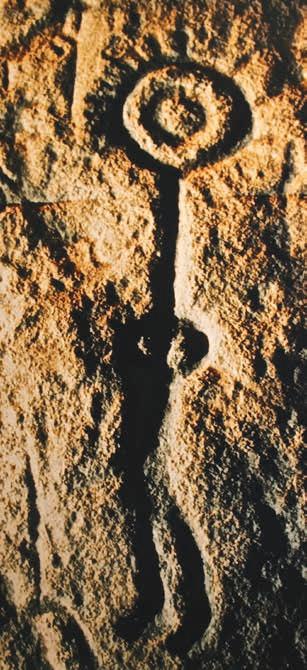


A close encounter with a moose.
“Thank you, sweetheart. I’m going to make you a star.” She awkwardly got up on her feet. I turned the camera back on. She walked slowly towards me, bent down, kissed the lens, then turned her head and slowly walked away. I think she went ahead to pass the word on to a few others, “This guy is OK. He has some contraption that won’t hurt you.” I attached the longer tripod legs as I approached a pond where a bull moose was swimming towards me. I kept the camera rolling as he slowly got out of the water and circled me to check me out. Canoeing in Algonquin Park it was as if, through some secret language, the moose had spread the word that it was Lloyd’s last shooting day for his film. “Hey gang, it’s your last chance to star.” Mom moose played with their kids. I filmed one female that looked like she was dangling a cigarette out of her mouth. Behind me, directly over my shoulder, I heard a loud “snort.” I slowly turned my head and looked up at a big black bull moose standing hip-deep in the water and breathing down my neck. A gentle puff of wind blew the canoe in a sideways motion, creating a tracking shot with the bow of the canoe and Bullwinkle moving in unison. Spread out over a year, it was only nine days of filming, but I had captured the yearly life-cycle of moose, and the body changes they go through in each season. I was getting closer to the intimacies of nature. Northern skies kept calling. Older doors began to open. This odyssey would bring rewards and consequences unforeseen and revelatory.
Chasing the Muse: Canada is available now on Amazon and in bookstores.
Vancouver Creatives Workshop
RAW Camera, Burnaby, BC. March 7, 2020
Moderators: John Banovich csc & Pieter Stathis csc
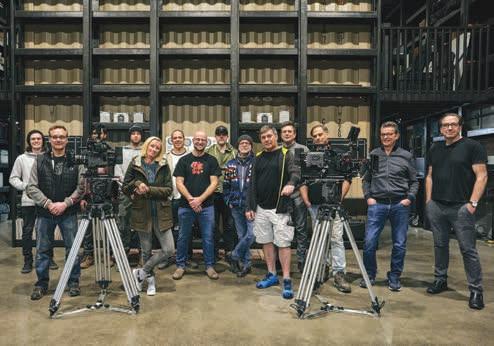
FILM STUDENTS
Are you graduating from a film or cinematography course and love the idea of becoming a professional cinematographer? JOIN OUR MENTOR PROGRAM
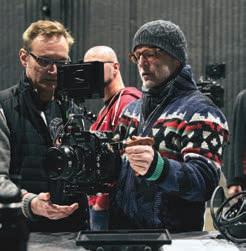
The hands-on workshop included DPs, directors and showrunners at Pieter Stathis’s RAW Camera Rentals and post facility in Burnaby. Moderators and participants used the Sony VENICE, RED MONSTRO and ARRI Mini LF in a side by side comparison, shooting extreme low light tests, reviewing the unprocessed material in post and then critiquing the colour graded versions in RAW Camera's DCP theatre. Highlights of the workshop included an overview of capabilities, features, codecs, menus, and 6K/4K workflow, with optimization for drama, documentaries, action, specialty shooting and natural history.

The participants (L-R): Alex Holley, John Banovich csc, Siddharth Chuahan, Doug Armer, Lindsay George, Paul Engstrom, Pieter Stathis csc, Kelly Fennig, Gary Harvey, Martin Wood, Jeffery Lando, Eric Goldstein, Michael Robison, Todd Williams. Bottom Left: John Banovich csc and Gary Harvey. Right: Pieter Stathis csc

Join the Canadian Society of Cinematographers as a STUDENT MEMBER And we will enrol you in our MENTOR PROGRAM. Check us out on at www.csc.ca or call the office at 416-266-0591 for more information
Slow Evolution of Battery Technology Sparks Innovative Solutions
Star Trek’s Scotty knew the problem all too well: “We dinnae have the power, Captain!” It’s a challenge familiar to those working on sets in isolated and remote locations where the budget doesn’t cover a generator or mobile battery truck. Power may in fact be the final frontier, and as cameras, monitors and lighting get smaller and less energy hungry, the timing for battery technology innovation couldn’t be more perfect. Batteries, as we know, are heavy, have a limited recharge lifecycle, take longer than we’d like to recharge and, of course, are expensive. There’s that old joke, you can double the price of anything by adding Corvette to its application, triple it by adding marine, and quadruple it by adding film industry. No, those Anton Bauers don’t come cheap, and that’s an issue for many small, self-funded productions and documentary makers. The long-standing issue prompted Vancouver DP Ian Kerr csc to post a

picture of his own DIY Rigid battery converter, though, as he notes, it was more of a fun idea. Sometimes innovation is an incremental step. As such, the Kessler Mag Max 3A enters the frame as a battery adapter that takes the DeWalt 20V Max and 60/20V Flex Volt batteries and outputs a regulated power stream of 14.4V 3A on a Lemo 2 pin, a 5.5 mm female connector and D-Tap connector. It’ll also accept a 5V USB to charge those all-important cell phones and other accessories. But why DeWalt, the tool maker whose yellow-and-black handheld power tools are ubiquitous with set crews? Precisely because they are ubiquitous, and since they’re not purpose-manufactured for a small market like cinematography, they’re reasonably priced and available at the local Home Depot or Rona, not to mention as generic brands online. “I started it as a kitchen counter project,” Director of Development & Marketing at Kessler Crane Michael Sutton says. “Back in 2000, I saw someone had made a DeWalt adapter for an Arri SR2. The product went away, and much later, around 2011, when the DeWalt Max 20 came out, I started again. A couple of people got interested, and we decided to make it here. I travel a lot, as do many other DPs, and batteries were always an issue. In Europe, it’s different and rental houses often only have D mounts. So it was an issue when you don’t have power.” DeWalt has consistently upped its battery game as its line of hand tools surged in sales. From the cumbersome 14/18v ni-cad of the early 2000s through the more expensive lithium-ion cells in the same form up to the current slimmer, lighter products that pack more punch in a smaller form, ranging from the 20V Max 3AH (amps/hour) to the 20V/60 9 AH and 12 AH. It’s a long slow journey of incremental advancement rather than revolutionary change, and battery density and lifecycle remain what’s called the Holy Grail of






